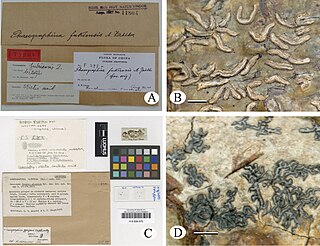
The Graphidaceae are a family of lichen-forming fungi in the order Graphidales. The family contains nearly a hundred genera and more than 2000 species. Although the family has a cosmopolitan distribution, most Graphidaceae species occur in tropical regions, and typically grow on bark.

The Stictidaceae are a family of fungi in the order Ostropales. It has 30 genera and about 240 species.
Lithoglypha is a fungal genus in the family Acarosporaceae. It is monotypic, containing the single species Lithoglypha aggregata, a saxicolous (rock-dwelling), crustose lichen found in South Africa.

Nadvornikia is a genus of lichen-forming fungi in the family Graphidaceae. Species in the genus are corticolous (bark-dwelling) and crustose.
Schizotrema is a genus of lichen-forming fungi in the family Graphidaceae. The genus was circumscribed in 2009 by Armin Mangold and H. Thorsten Lumbsch.
Ocellularia upretii is a species of corticolous (bark-dwelling) lichen in the family Graphidaceae. It is found in India.

Graphidales is an order of lichen-forming fungi in the class Lecanoromycetes. It contains 6 families, about 81 genera and about 2,228 species. Family Graphidaceae are the largest crustose family within Graphidales order comprising more than 2000 species, which are widely distributed in tropical and subtropical regions of the world.
Clandestinotrema is a genus of lichen-forming fungi in the family Graphidaceae. It has 17 species. They typically inhabit montane and cloud forest at higher elevations in the tropics.
Diorygma archeri is a species of corticolous (bark-dwelling) lichen in the family Graphidaceae. Found in Vietnam, it was formally described as a new species in 2013 by Santosh Joshi and Jae-Seoun Hur. The type specimen was collected from Yok Đôn National Park at an altitude of about 760 m (2,490 ft). The species epithet honours Australian lichenologist Alan W. Archer.
Topeliopsis acutispora is a species of crustose lichen in the family Graphidaceae. It is found in New South Wales and southern Queensland (Australia), where it grows on bryophytes.
Austrotrema is a genus of lichen-forming fungi in the family Graphidaceae. It is primarily found in the Australian-Southeast Asian region. The genus is characterized by small, pore-like apothecia with a double margin, faintly amyloid ascospores, and stictic acid chemistry. Austrotrema species grow on tree bark and have a continuous thallus with a cortex that is prosoplectenchymatous–featuring densely packed, filamentous fungal hyphae that run parallel to the surface of the lichen, creating a compact and firm texture. The genus is closely related to Thelotrema and Leucodecton, but can be distinguished from them based on molecular phylogenetic data, specific morphological traits, and its secondary chemistry. Currently, Austrotrema comprises three species.
Asteristion is a genus of lichen-forming fungi in the family Graphidaceae. It has seven species. Previously considered a synonym of either Phaeotrema or Thelotrema, molecular evidence led to its resurrection as a distinct genus. Asteristion lichens are corticolous (bark-dwelling), featuring a continuous thallus with a loose to hardened cortex and a photobiont layer containing calcium oxalate crystals. The ascomata, or fruiting bodies, are characterized by their large, often chroodiscoid appearance and the presence of distinct periphysoids. The secondary chemistry of these lichens includes major concentrations of stictic acid and minor to trace amounts of associated substances.
Xalocoa is a single-species fungal genus in the family Graphidaceae. The genus was circumscribed in 2013 by lichenologists Ekaphan Kraichak, Robert Lücking, and H. Thorsten Lumbsch. It contains Xalocoa ocellata, a corticolous (bark-dwelling), crustose lichen that was originally described by Elias Magnus Fries in 1831.
Gintarasia is a genus of lichen-forming fungi in the family Graphidaceae. It has seven species, all of which are found in Australia. Gintarasia species are corticolous (bark-dwelling), crustose lichens with a thelotremoid form.
Glyphis frischiana is a species of corticolous (bark-dwelling) script lichen in the family Graphidaceae. It is distinguished by its large ascospores, single-spored asci, and the presence of stictic acid as a major metabolite. Found on the trunk of Eucalyptus trees in Cameroon, it is similar in appearance to Glyphis atrofusca but can be distinguished by these key characteristics.
Ocellularia vizcayensis is a rare species of corticolous (bark-dwelling) lichen in the family Graphidaceae. It is known from a single collection made in Luzon, Philippines. The lichen thallus is a white, irregularly structured, areolate surface with a layer that includes a photosynthetic partner, both containing large calcium oxalate crystals. Its fruiting bodies are either embedded or protruding, round, with very narrow openings, and contain large, oblong, colorless spores that turn violet-blue when stained with iodine.
Tricharia nigriuncinata is a species of foliicolous (leaf-dwelling) lichen in the family Gomphillaceae. It is found in East Africa.
Crutarndina is a monotypic fungal genus in the family Graphidaceae. It contains the single species Crutarndina petractoides, a corticolous (bark-dwelling), crustose lichen.

Mangoldia is a genus of lichen-forming fungi in the subfamily Graphidoideae of the family Graphidaceae. It contains four species of corticolous (bark-dwelling) script lichens.
Corticorygma is a monotypic fungal genus in the subfamily Graphidoideae of the family Graphidaceae. It contains a single species, the corticolous (bark-dwelling) crustose lichen Corticorygma stellatum. This script lichen is found in the shaded understory of rainforests in the Brazilian states of Rondônia and Paraná.




